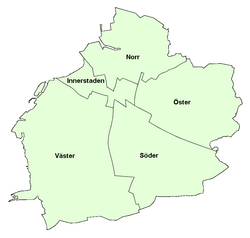Stockholm
Overview

Metropolitan Stockholm consists of 26 municipalities, each municipality is divided into smaller subdivisions/districts.
Stockholm Municipality uses the English term "city district departments" (stadsdelområde) to describe these subdivisions. [1]
The districts were first created in 1997 to facilitate the efficiency of local government in Stockholm. The number of districts was reduced from 24 to 18 the following year, and reduced again to the 14 in 2007. Since the establishment of these districts, certain administrative tasks, such as school administration were re-centralized.[ citation needed ]
Each district has its own district administration, led by a district council, which is responsible for certain areas of municipal governance within their district, including pre-school education, park maintenance, local economic initiatives, elderly services, financial counseling, and refugee reception services. Individual district councils have no power over city planning or tax policy, both of which are retained by the central city council. [2] [3]
The councilors that serve on these district councils are often part-time politicians, also holding other employment. They are preferably residents of the district whose council they serve upon. The central city council itself is responsible for setting the budget, goals, and responsibilities of the district councils. The city council also appoints the members of each district council, so the political makeup of the district council resembles that of the central city council, not necessarily that of the district. The member of the district council are not elected in any fashion by the residents of the district in question. [3]
Stockholm's districts are sometimes divided into smaller parts for statistical purposes, however these smaller districts have no administrative function in the city's governance.[ citation needed ]
Districts
As of 2024 [update] , Stockholm Municipality has eleven districts: [4]

From 1997, Stockholm had 24 districts. On 1 January 1999, the number of districts were reduced to 18: Enskede and Årsta merged to Enskede-Årsta; Hässelby and Vällingby merged to Hässelby-Vällingby; Västerled joined Bromma; Söderled joined Farsta; Hornstull joined Maria-Gamla stan; and Hammarby was split between Skarpnäck och Katarina-Sofia. [5]
On 1 January 2007, the number of districts were reduced to 14: Enskede-Årsta och Vantör merged to Enskede-Årsta-Vantör; Hägersten and Liljeholmen merged to Hägersten-Liljeholmen, Kista and Rinkeby merged to Rinkeby-Kista; and Maria-Gamla stan and Katarina-Sofia merged to Södermalm. [6]
On 1 July 2020, Älvsjö and Hägersten-Liljeholmen merged to Hägersten-Älvsjö. [7] On 1 July 2023, two new mergers occurred: Rinkeby-Kista and Spånga-Tensta merged to Järva; and Östermalm and Norrmalm to Norra innerstaden. [8]
Boroughs
Metropolitan Stockholm has 26 municipalities (boroughs):

